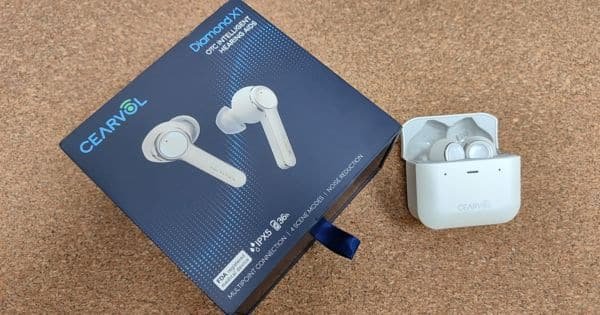
Cearvol Nano Review: The $299 In-Canal Hearing Aids with a Brilliant Charging Case Remote
After two tympanoplasty surgeries for chronic otitis media that left me with low-frequency hearing loss from eardrum perforations, I’ve become something of an OTC hearing aid connoisseur. When traditional hearing aids can cost more than a high-end smartphone, the emerging OTC market offers compelling alternatives. The Cearvol Nano caught my attention with its promise of complete invisibility and a unique charging case that actually lets you control the devices without a smartphone.

Table of Contents
We Like
Innovative charging case remote with physical buttons for volume and program control
Completely invisible design when worn—true CIC-style discretion
Senior-friendly physical controls eliminate smartphone dependency
Exceptional value at just $299
Compact charging case easily fits in any pocket
Excellent performance in quiet to moderate environments
We Don't Like
Limited ear tip selection may affect fit and noise isolation
Noise reduction struggles in extremely loud environments like subways
Removal thread slightly visible at very close range
Bass response limited for severe low-frequency hearing loss
Summary
The Cearvol Nano delivers where it matters most for mild to moderate hearing loss. Its ingenious charging case with physical buttons provides tactile feedback and simplicity that smartphone apps can’t match—especially valuable for older users who prefer straightforward controls. While it won’t replace premium prescription hearing aids in challenging environments, it offers remarkable performance for everyday use at a fraction of the cost.
Design and Unboxing: Premium and practical




Right out of the gate, the Nano makes a better impression than many OTC competitors. The packaging feels premium—a step up from Cearvol’s previous offerings and certainly more refined than the typical medical-looking hearing aid packaging.
Inside the box, you’ll find:
The star of the show: A charging case with integrated physical controls
A pair of Cearvol Nano hearing aids (with medium tips pre-installed)
Two additional pairs of silicone ear tips (small and large)
A USB-C charging cable (no power adapter included, as is standard nowadays)
A cleaning tool
The Nano devices themselves resemble traditional CIC (completely-in-canal) hearing aids rather than the TWS earbud style that dominates the OTC market. The most noticeable feature is the nearly invisible removal thread—a practical necessity given how deeply these sit in your ear canal. While this thread is subtly visible at very close range, these are easily the most discreet OTC hearing aids I’ve tested.
The charging case remote: A game-changer for older users



This is the Nano’s killer feature. While most OTC hearing aids force you to fiddle with smartphone apps or frustrating touch controls, Cearvol’s charging case features actual physical buttons: volume controls on one side (+/-) and program/mode buttons on the other.
The advantages are immediately apparent:
Tactile certainty: You feel the click and know the command registered—no guessing if you tapped correctly
Senior-friendly operation: Eliminates the smartphone learning curve that frustrates many older users
Instant access: Adjust settings without digging out your phone and opening an app
Reliability: Physical buttons work every time, unlike Bluetooth connections that can drop
In practice, I found this design incredibly useful when moving between environments. Walking from a quiet office to a noisy street? I could adjust the settings while taking the devices out of the case—no smartphone required.
Fit and Comfort: Almost perfect
The Nano’s tiny size makes it initially comfortable to wear, though the limited ear tip selection might be an issue for some users. I needed a slightly larger tip for my right ear to achieve a proper seal—crucial for both sound quality and preventing feedback whistle. The removal thread provides peace of mind, though I was occasionally aware of its presence.
Performance: Environment is everything
Quiet environments (home/office): ★★★★★
In quiet settings, the Nano performs exceptionally well. Speech clarity is impressive, with natural sound reproduction that doesn’t exaggerate background noises. For my low-frequency hearing loss, it provided just the right amount of amplification without overdoing it.
Moderate noise (McDonald’s/café): ★★★☆☆
In typical restaurant environments, the Nano delivers adequate but not exceptional performance. While it amplifies conversation, it also brings up background noises (kitchen equipment, other patrons). The physical mode buttons on the charging case proved useful here—I could quickly switch to a noise-reduction mode when needed.
High noise (subway/traffic): ★★☆☆☆
Like most OTC hearing aids, the Nano reaches its limits in extremely noisy environments. Subway rumble and traffic noise tend to overwhelm the system, though it still provides some benefit over unaided listening. Those needing significant support in such environments would likely require prescription solutions.
Battery Life and Value Proposition
Battery life meets expectations—a full day on a single charge plus multiple additional charges from the case. The case itself, while slightly bulkier than some competitors due to the integrated controls, still easily fits in a pocket or small bag.
At $299, the Nano represents exceptional value. This positions it as a genuine alternative to prescription hearing aids that typically cost $1,500-$3,000 per pair. For those new to hearing assistance or with budget constraints, the Nano makes hearing help truly accessible.
The Competition and Who Should Buy This
The Nano’s physical controls give it a distinct advantage over smartphone-dependent competitors like the Jabra Enhance Plus or Bose SoundControl. Its completely-in-canal design also makes it more discreet than most OTC options.
Who should buy the Cearvol Nano:
Seniors and technophobes who prefer physical buttons over smartphone apps
Value-conscious users needing mild to moderate hearing support
Discretion seekers who want completely invisible hearing assistance
First-time users hesitant to invest in prescription hearing aids
Who should look elsewhere:
Those with severe hearing loss requiring professional fitting
People who primarily need assistance in extremely noisy environments
Users who prefer advanced smartphone integration and customization
Conclusion
The Cearvol Nano succeeds by focusing on what matters most to everyday users: discretion, simplicity, and value. That brilliant charging case with physical controls isn’t just a gimmick—it’s a genuinely thoughtful solution that makes hearing assistance more accessible to those who need it most. While it won’t replace premium prescription devices for challenging listening situations, it delivers remarkable performance for typical daily use at a truly revolutionary price point.


